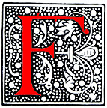
rank Stone, the artist, illustrator, amateur actor and companion of Charles Dickens, also served as the primary fine arts reviewer for the influential London literary journal Athenaeum during the mid-nineteenth century. As such, in May 1849 he was assigned to review the Royal Academy's Annual Exhibition, the most important artistic event of the year.
Following the formation of the Pre-Raphaelite Brotherhood in the autumn of 1848, three of its seven members, John Everett Millais, William Holman Hunt and James Collinson, exhibited paintings at the RA Exhibition of 1849. Although all three artists had previously exhibited at the RA, this was the first year in which they appended the then-secret initials "P.R.B." to their signatures and painted in the early Pre-Raphaelite style.
Frank Stone's exhibition review included a lengthy discussion of Millais's Isabella and Hunt's Rienzi. And though he praised the "ability and spirit" of the young artists, he was severely critical of their attempt to imitate the "antiquarian" style of the early Renaissance artists to whom the Pre-Raphaelites looked for inspiration. Frank Stone's negative comments incensed the temperamental Pre-Raphaelites. Though the Athenaeum reviews were published anonymously, the Pre-Raphaelites had a strong suspicion that Stone was responsible for the uncomplimentary treatment of their paintings. Accordingly, they dubbed him the "Unmentionable", and referred to him only by this nickname or by the initials "F.S.".
In early 1850, William Michael Rossetti was appointed as the arts reviewer for a reputable journal known as the Critic. His first assignment was to write a review of the British Institution's exhibition of modern painters. His brother Dante Gabriel Rossetti accompanied him to the exhibition, and the two agreed to divide the work of reviewing the paintings. Frank Stone's painting Sympathy was among the works exhibited, and Gabriel, in an exercise of colossally poor judgment, published a caustic review in which he compared the features of the two ladies depicted to wax, wool and soap, and concluded that such pictures would not sustain Mr. Stone's reputation.
Rossetti's negative review had important consequences for the Pre-Raphaelites. Whereas in 1849 Frank Stone had simply admonished the young artists to improve various aspects of their painting, his review of their works in the 1850 Royal Academy Exhibition constituted an all-out attack. He singled out Millais, Hunt and Rossetti for special censure, and publicly ridiculed the now-revealed meaning of P.R.B. Stone's review signaled the beginning of a firestorm of criticism that culminated with a scathing rebuke by Charles Dickens himself. In the weekly publication Household Words, Dickens lavished ridicule and contempt on Millais's painting Christ in the House of his Parents, calling it "mean, odious, repulsive, and revolting", and continuing for three pages to enumerate the fallacies and pretensions of the Pre-Raphaelites' thinking.
This criticism continued in much the same vein the following year, and it only abated with the intervention of John Ruskin, whose influential letters to the Times in the Pre-Raphaelites' defense finally began to turn the tide of popular sentiment in their favor.
References
Dickens, Charles. "Old Lamps from New Ones." Household Words 12 (15 June 1850): 12-14.
Fredeman, William E. (ed.). The P.R.B. Journal. Oxford: Clarendon Press, 1975.
Rossetti, Dante Gabriel (William Michael Rossetti, ed.). The Works of Dante Gabriel Rossetti. London: Ellis, 1911.
Rossetti, William Michael. Dante Gabriel Rossetti: His Family-Letters with a Memoir (vol 1). London: Ellis, 1895.
[Stone, Frank]. "Fine Arts. Royal Academy. Paintings." Athenaeum (2 June 1849): 575.
[Stone, Frank]. "The Royal Academy". Athenaeum (1 June 1850): 590-91.
Last modified 16 February 2005